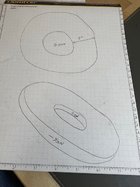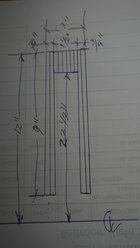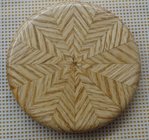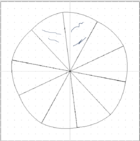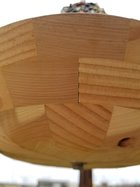Al, I think Jerry's base would help for sure, but at this size it would still be at risk of failure at the outside where the wide rings join to adjacent rings. I think the plywood concept where there are several layers with the grain staggered at 90deg each layer would help balance all the movement out.
Jim, Jerry's concept is illustrated below. With this the grain direction is at 45deg to the center line of the segments. The segments are arranged to alternate the grain direction. This balances out the movement so the segment joins are happy. But it still allows distortion at the outer edge which could lead to a joint failure at the size of your project. Hard to say for sure.
View attachment 58967
Exaggerated distortion at edge with added moisture content.....
View attachment 58968
I built a few of these rings and did some extreme testing. Mine were about 8" diameter. I baked them dry and then soaked them to a high moisture content and as stand-alone rings they survived but took on the distorted shape shown above. I then added regular segmented rings to build it into a box and repeated. They failed joints in the adjacent rings. Pretty extreme conditions, but the large size of your project will make the situation worse than my 8" rings.
One of the test pieces was built into a bird feeder and is hanging outside. It rained for a few days here in Iowa and the joints on the adjacent ring are starting to fail.
View attachment 58969
I'm not sure what you plan to use your wheel for. If it is an indoor project in a stable environment, this concept might work. If it is a waterwheel for a mill....... Likely not going to work.


